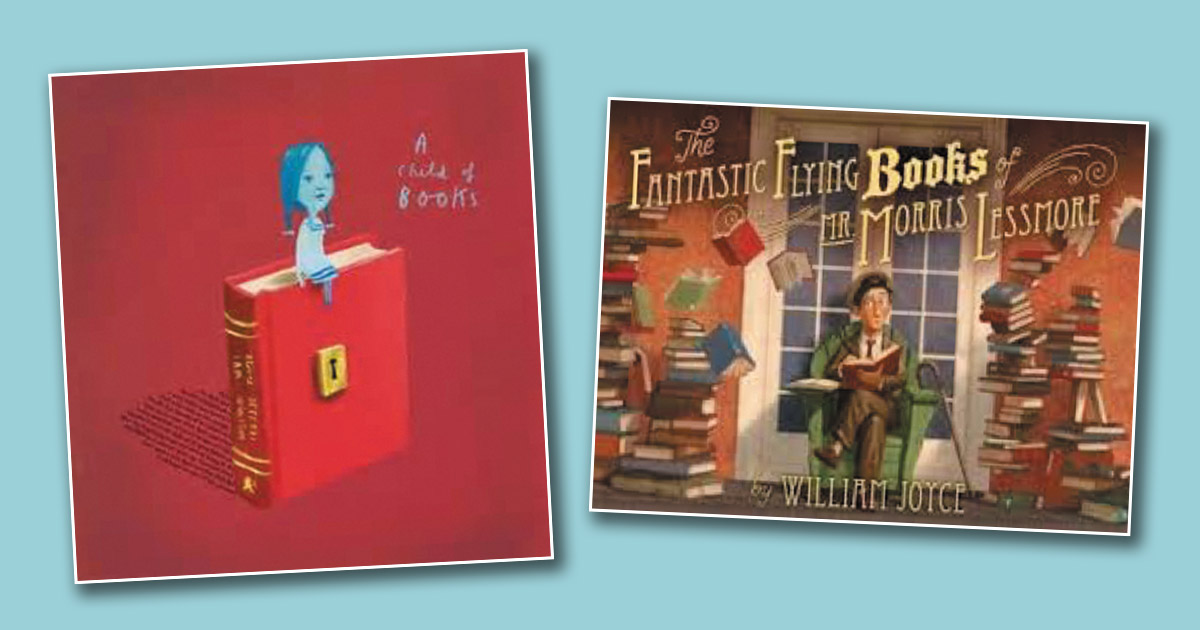Each month I spotlight two books guaranteed to delight readers and provide fun activities to further extend the meaning of each reading experience. With so many wonderful titles available, this is no easy task! I bring a 34-year teaching career, literacy expertise, and a passion for creating joyful readers to every column I write. I certainly hope you enjoy this month’s picks as much as I do.
IMAGINATION
Creativity and thinking outside the box begin in the realm of imagination. Educational experts validate what parents, grandparents, and teachers have known all along—offering children opportunities to play with blocks, cardboard boxes, rocks, and stuffed animals provides a rich context for exploring the world. What child can resist concocting magical potions from dirt, water, and a few dried leaves, or crafting whimsical, flying beasts from colorful play dough? Not only does imagination foster cognitive and social-emotional development, but the planning, questioning, experimenting, and problem-solving that accompany these creative endeavors are the very skills children will need to enter the workplace of the future successfully.
Imagination is more important than knowledge. Imagination points to all we might yet discover and create. ~ Einstein
Top Ten Tips for Nurturing Children’s Imagination:
- Encourage art activities—any art medium is a perfect choice!
- Spend time outside—discovery opportunities are endless (nature is always changing).
- Ask thought-provoking questions—celebrate all ideas!
- Limit screen time—television, computer, tablet, smart phones, etc.
- Tell stories—real or imagined (big emotions are encouraged).
- Invent scenarios—stuffed animals or sock puppets enhance storylines.
- Rhymes, riddles, familiar songs—create new verses (the sillier, the better).
- Write for fun—play with language (writing to music increases creativity).
- Be curious (ask how?, why?, what if?).
- Read more books that stretch your imagination!
Every child is born blessed with a vivid imagination. ~ Walt Disney
A CHILD OF BOOKS
Best-selling author Oliver Jeffers and typographical fine artist Sam Winston have collaborated to create a most unique reading experience that celebrates the power of storytelling and imagination! Within the pages of this picture book, a nameless girl, “a child of books who comes from a world of stories,” sails upon a float of imagination across a sea of words to ask if a young boy (who has not yet discovered the secrets of literature and imagination) will join her on what will be a truly unforgettable journey. Narrated by the little girl in lyrical verse, and accentuated by mixed-media illustrations and objects built from words borrowed from over 40 children’s classic novels (and a few nursery rhymes), this book is a work of art that can be enjoyed by young and old alike. Careful attention to every detail renders this a refreshingly clever book about words and storytelling, and as the last lines of the book reminds readers, “Anyone can come. For imagination is free.”
THE FANTASTIC FLYING BOOKS OF MR. MORRIS LESSMORE
Author/illustrator William Joyce tells the story of Morris Lessmore whose life is “a book of his own writing…one orderly page after another.” On the heels of a catastrophic storm, Morris’ life is turned upside down. His beloved, personal library is missing, the city is in shambles, and a flurry of loose book pages swirls overhead. A vibrant lady, “pulled along by a festive squadron of flying books,” sends down a book featuring Humpty Dumpty and beckons Morris to an abandoned library in the countryside. Upon entry, Morris realizes the books are very much alive—circling him with fluttering book cover wings, asking to be read. Morris takes excellent care of the books, shares some of his favorites with neighbors, and in time, picks up his pen and writes once more. Years later, “stooped and crinkly,” Morris completes his book and, satisfied with the story, closes the cover. The books which “read themselves to him each night” and cared for him as he grew old, spiral around him as he heads for the door. This tale speaks to the transformative power of books and the importance of keeping a story alive by sharing it with others.
EXTENSION ACTIVITIES:
Personal Picture Dictionary
In The Fantastic Flying Books of Mr. Morris Lessmore, the “great big dictionary got in the last word each night.” Be a word collector by creating a personal picture dictionary—an authentic place to collect and access “words with personal significance” which will facilitate vocabulary development and support reading and writing achievement.
- With your child, take a close look at a “First Dictionary” and notice how words and corresponding pictures are organized alphabetically.
- Permit your child to find pictures of interest from old magazines/online sources (e.g. stock.adobe.com) and cut them out or draw pictures of favorite people, places, and things. (Pre-cut/pre-drawn images for younger children can be used.)
- Child cuts and glues each image to the top portion of a 5″x 8″ index card (holes punched in the top left corner and a horizontal line drawn across the length of the index card, one inch from the bottom, ahead of time).
- The child writes (or adult scribes) the name of each image below the horizontal line—one image per index card. (Older children can add a sentence about the picture beneath the label.)
- Make a cover with a title for the personal picture dictionary on a separate index card.
- Assist your child in organizing the cards in alphabetical order and then place a small binder ring or ribbon through the holes to secure the index cards.
- Enjoy reading the personal picture dictionary. Continue adding index cards with illustrated words over time to grow the collection.
Literature Scavenger Hunt
In A Child of Books, there are excerpts from dozens of children’s classic stories woven throughout. See how many of the following familiar tales you can find:
- Pinocchio
- Alice in Wonderland
- Beauty and the Beast
- Hansel and Gretel
- Peter Pan
- Rapunzel
- Peter Rabbit
- Tom Thumb
International Book Giving Day 2018
In both of the featured books this month, the common theme is the power of books as a way to stretch the imagination, learn more about the world, increase vocabulary, enhance reading and writing skills, and stimulate the mind. A book…such power! Each year, on February 14th, millions of people around the world join together to place new or slightly used books into the hands of as many children as possible. It may be that the book you place into the hands of a child is the only book they will ever own and…that one act of kindness may make all the difference. The following are a few ways to get involved with International Book Giving Day:
- Place a book where children must wait, such as a doctor’s office, dental clinic, car repair shop or bus station.
- Donate a book to the playroom on the children’s floor/wing of a local hospital.
- Leave a book where a child will find it with a message telling them it is your gift to them—a restaurant with a play area, a park, or some other child-friendly venue.
- Give a book you have loved and outgrown to another family for their child’s enjoyment.
- Share a book with a shelter for the homeless/refugees. Smaller books are ideal for ease of transporting.
Books build a stairway to your imagination. ~ Andrew Guzaldo























